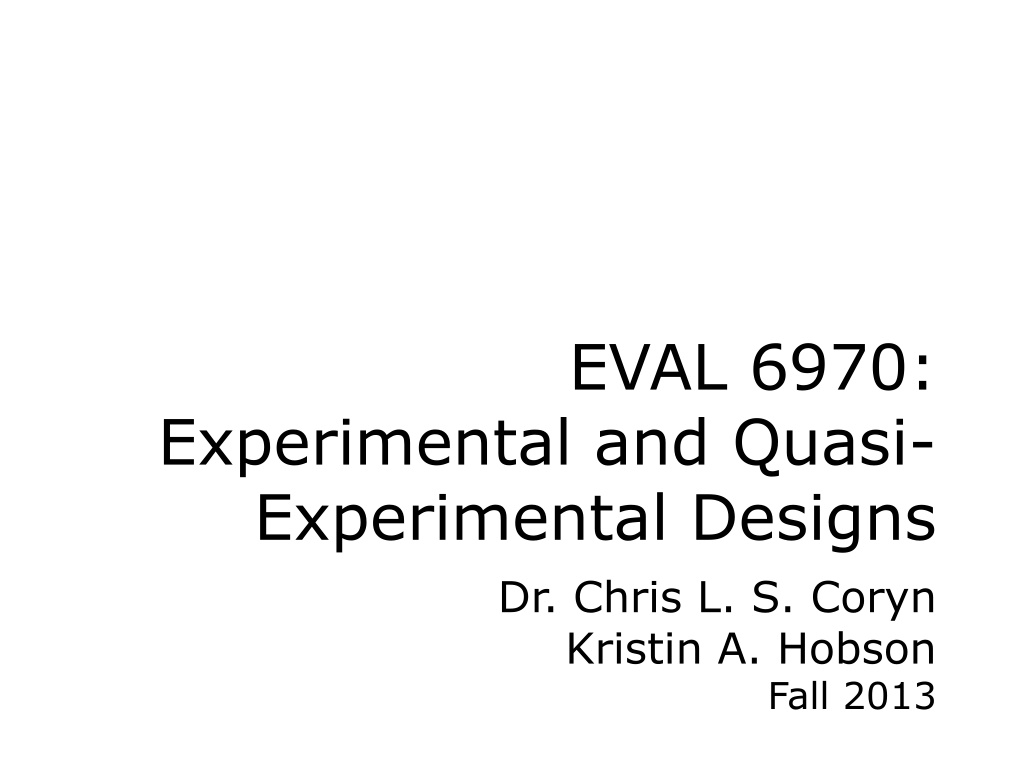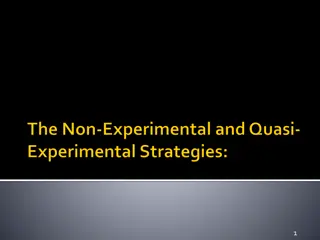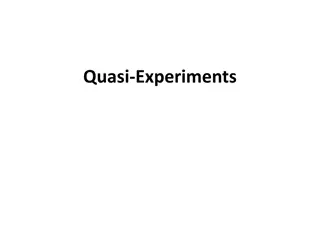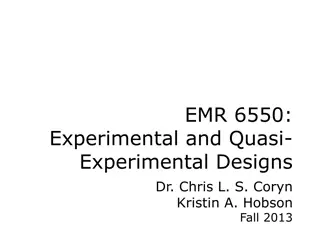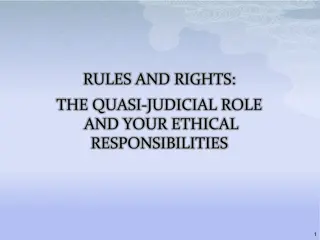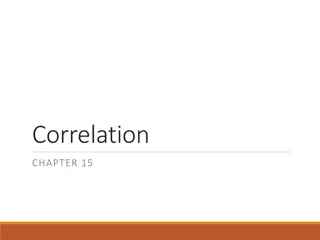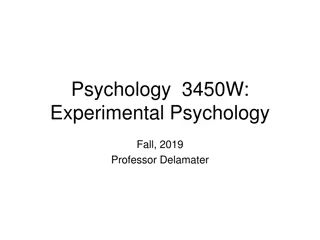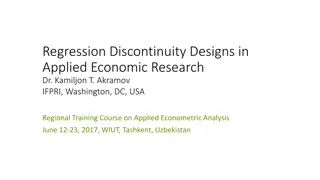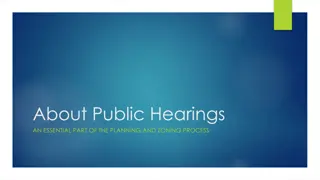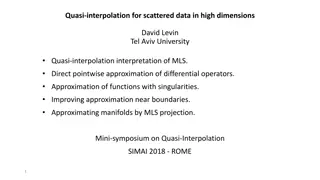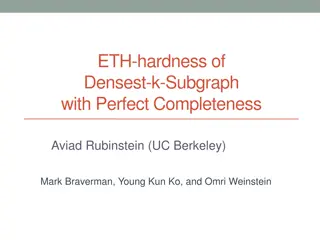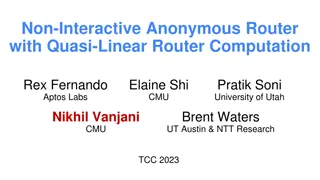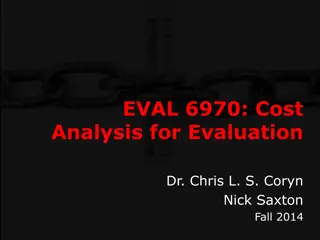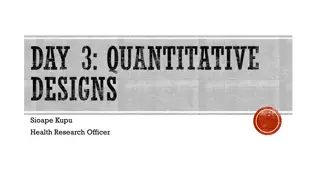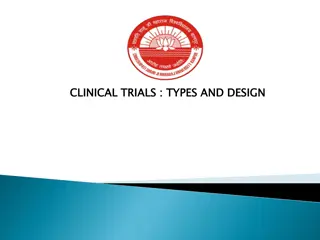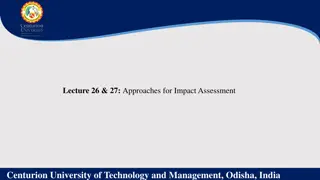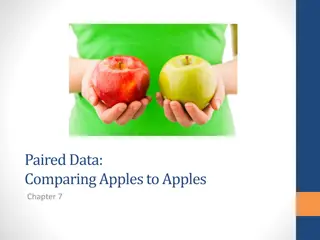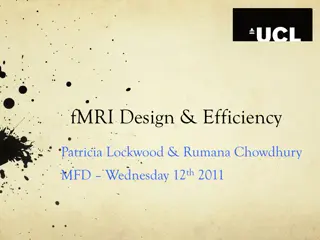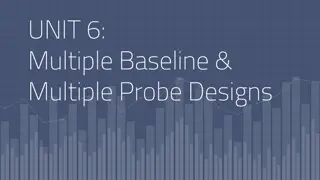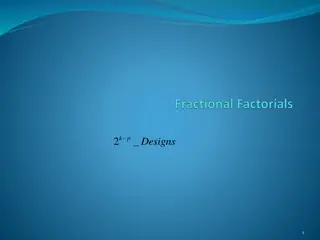Understanding Experimental and Quasi-Experimental Designs
Explore the foundations of experimental and quasi-experimental designs, delving into causal relationships, counterfactual reasoning, and the importance of validating statistical and internal conclusions. Learn about causes, effects, and the complexity of determining causation in research. Discover Rubin's Causal Model and key principles for establishing causal relationships in experiments.
Download Presentation

Please find below an Image/Link to download the presentation.
The content on the website is provided AS IS for your information and personal use only. It may not be sold, licensed, or shared on other websites without obtaining consent from the author. Download presentation by click this link. If you encounter any issues during the download, it is possible that the publisher has removed the file from their server.
E N D
Presentation Transcript
EVAL 6970: Experimental and Quasi- Experimental Designs Dr. Chris L. S. Coryn Kristin A. Hobson Fall 2013
Agenda Experiments and generalized causal inference Statistical conclusion validity Internal validity
Cause Variable that produces an effect or result Most causes are inus (insufficient but nonredundant part of an unnecessary but sufficient condition) Many factors are required for an effect to occur, but they can rarely be fully known and how they relate to one another
Effect Difference between what did happen and what would have happened This reasoning generally requires a counterfactual
Counterfactual Knowledge of what would have happened in the absence of a suspected causal agent Physically impossible Impossible to simultaneously receive and not receive a treatment Therefore, the central task of all cause- probing research is to approximate the physically impossible counterfactual
Causal Relationships A causal relationship requires three conditions: 1. Cause preceded effect (temporal precedence) 2. Cause and effect covary 3. No other plausible alternative explanations can account for a causal relationship
Causal Relationships Rubin s Causal Model Intuitively, the causal effect of one treatment, E, over another, C Subject Joe Jim Jane Bob Bill Jill Mary Mark MEAN YE 5 6 ? ? 5 ? 5 ? YC ? ? 2 3 ? 2 ? 3 YE YC ? ? ? ? ? ? ? ? 2.75 5.25 2.50
Cause, Effect, and Causal Relationships In experiments: 1. Presumed causes are manipulated to observe their effect 2. Variability in cause related to variation in an effect 3. Elements of design and extra-study knowledge are used to account for and reduce the plausibility of alternative explanations
Causation, Correlation, and Confounds Correlation does not prove causation Correlations do not meet the first premise of causal logic (temporal precedence) Such relationships are often due to a third variable (i.e., a confound)
Manipulable and Nonmanipulable Causes Experiments involve causal agents that can be manipulated Nonmanipulable causes (e.g., ethnicity, gender) cannot be causes in experiments because they cannot be deliberately varied
Causal Description and Causal Explanation Causal description is identifying that a causal relationship exists between A and B Molar causation is the overall relationship between a treatment package and its effects Causal explanation is explaining how A causes B Molecular causation is knowing which parts of a treatment are responsible for which parts of an effect
Modern Descriptions of Experiments
Randomized Experiment Units are assigned to conditions randomly Randomly assigned units are probabilistically equivalent based on expectancy (if certain conditions are met) Under the appropriate conditions, randomized experiments provide unbiased estimates of an effect
Quasi-Experiment Shares all features of randomized experiments except assignment Assignment to conditions occurs by self-selection Greater emphasis on enumerating and ruling out alternative explanations Through logic and reasoning, design, and measurement
Natural Experiment Naturally-occurring contrast between a treatment and comparison condition Typically concern nonmanipulable causes Requires constructing a counterfactual rather than manipulating one
Nonexperimental Designs Often called correlational or passive designs (i.e., cross-sectional) Statistical controls often used in place of structural design elements Generally do not support strong causal inferences
Experiments and the Generalization of Causal Connections
Most Experiments are Local but have General Aspirations Most experiments are localized Limited samples of units, treatments, observations, and settings (utos) What Campbell labeled local molar causal validity
Construct Validity: Causal Generalization as Representation Premised on generalizing from particular sampled instances of units, treatments, observations, and settings to the abstract, higher order constructs that sampled instances represent
External Validity: Causal Generalization as Extrapolation Inferring a causal relationship to unsampled units, treatments, observations, and settings from sampled instances Enhanced when probability sampling methods are used Broad to narrow Narrow to broad
Approaches to Making Causal Generalizations Sampling Probabilistic Heterogeneous instances Purposive Grounded theory 1. Surface similarity 2. Ruling out irrelevancies 3. Making discrimination 4. Interpolation and extrapolation 5. Casual explanation
Statistical Conclusion Validity and Internal Validity
Validity Approximate truthfulness of correctness of an inference Not an all or none, either or, condition, rather a matter of degree Efforts to increase one type of validity often reduce others
Statistical Conclusion Validity Validity of inferences about the covariation between treatment (cause) and outcome (effect)
Internal Validity Validity of inferences about whether observed covariation between A (treatment/cause) and B (outcome/effect) reflects a causal relationship from A to B as those variables were manipulated or measured
Construct Validity Validity of inferences about the higher order constructs that represent sampling particulars
External Validity Validity of inferences about whether a cause-effect relationship holds over variations in units, treatments, observations, and settings
Threats to Validity Reasons why an inference may be partly or wholly incorrect Design controls can be used to reduce many validity threats, but not in all instances Threats to validity are generally context-dependent
Statistical Conclusion Validity Whether a presumed cause and effect covary The magnitude of covariation Concerned with Type I and Type II errors
Reporting Results of Statistical Tests of Covariation Emphasis should be placed on effect sizes and confidence intervals rather than null hypothesis statistical significance testing (NHST) Confidence intervals provide all of the information provided by NHST but focus attention on the magnitude of an effect and the precision of the effect estimate
Threats to Statistical Conclusion Validity 1. Low statistical power. An insufficiently powered experiment may incorrectly conclude that the relationship between cause and effect is not statistically significant 2. Violated assumptions of statistical test. Violations of statistical test assumptions can lead to either overestimating or underestimating the size and significance of an effect 3. Fishing and the error rate problem. Repeated tests for significant relationships, if uncorrected for the number of tests, can artificially inflate statistical significance 4. Unreliability of measures. Measurement error weakens the relationship between two variables 5. Restriction of range. Reduced range on a variable usually weakens the relationship between it and another variable
Threats to Statistical Conclusion Validity 6. Unreliability of treatment implementation. If a treatment is intended to implemented in a standardized manner is implemented only partially for some respondents, effects may be underestimated 7. Extraneous variance in experimental setting. Some features of an experimental setting may inflate error, making detection of an effect more difficult 8. Heterogeneity of units. Increased variability on the outcome variable within conditions increases error variance, making detection of a relationship more difficult 9. Inaccurate effect size estimation. Some statistics systematically overestimate or underestimate the size of an effect
Internal Validity Inferences about whether the observed covariation between A and B reflects a causal relationship from A to B in the form in which the variables were manipulated or measured In most cause-probing studies, internal validity is the primary focus
Threats to Internal Validity 1. Ambiguous temporal precedence. Lack of clarity about which variable occurred first may yield confusion about which variable is the cause and which is the effect 2. Selection. Systematic differences over conditions in respondent characteristics that could also cause the observed effect 3. History. Events occurring concurrently with treatment that could cause the observed effect 4. Maturation. Naturally occurring changes over time that could be confused with a treatment effect 5. Regression. When units are selected for their extreme scores, they will often have less extreme scores on other variables, an occurrence that can be confused with a treatment effect
Threats to Internal Validity 6. Attrition. Loss of respondents to treatment or measurement can produce artifactual effects if that loss is systematically correlated with conditions 7. Testing. Exposure to a test can affect test scores on subsequent exposures to that test, an occurrence that can be confused with a treatment effect 8. Instrumentation. The nature of a measure may change over time or conditions in a way that could be confused with a treatment effect 9. Additive and interactive threats. The impact of a threat can be added to that of another threat or may depend on the level of another threat
Estimating Internal Validity in Experiments By definition randomized experiments eliminate selection through random assignment to conditions Most other threats are (should be) probabilistically distributed as well
Estimating Internal Validity in Experiments Only two likely validity threats (typically) arise from experiments 1. Attrition 2. Testing
Estimating Internal Validity in Quasi-Experiments Differences between groups tend to be more systematic than random All threats should be made explicit and then ruled out one by one Once identified, threats can be systematically examined
The Relationship Between Statistical Conclusion Validity and Internal Validity
Similarities Both statistical conclusion validity and internal validity are concerned with study operations (rather than the constructs those operations are intended to represent) and with the relationship between treatment and outcome.
